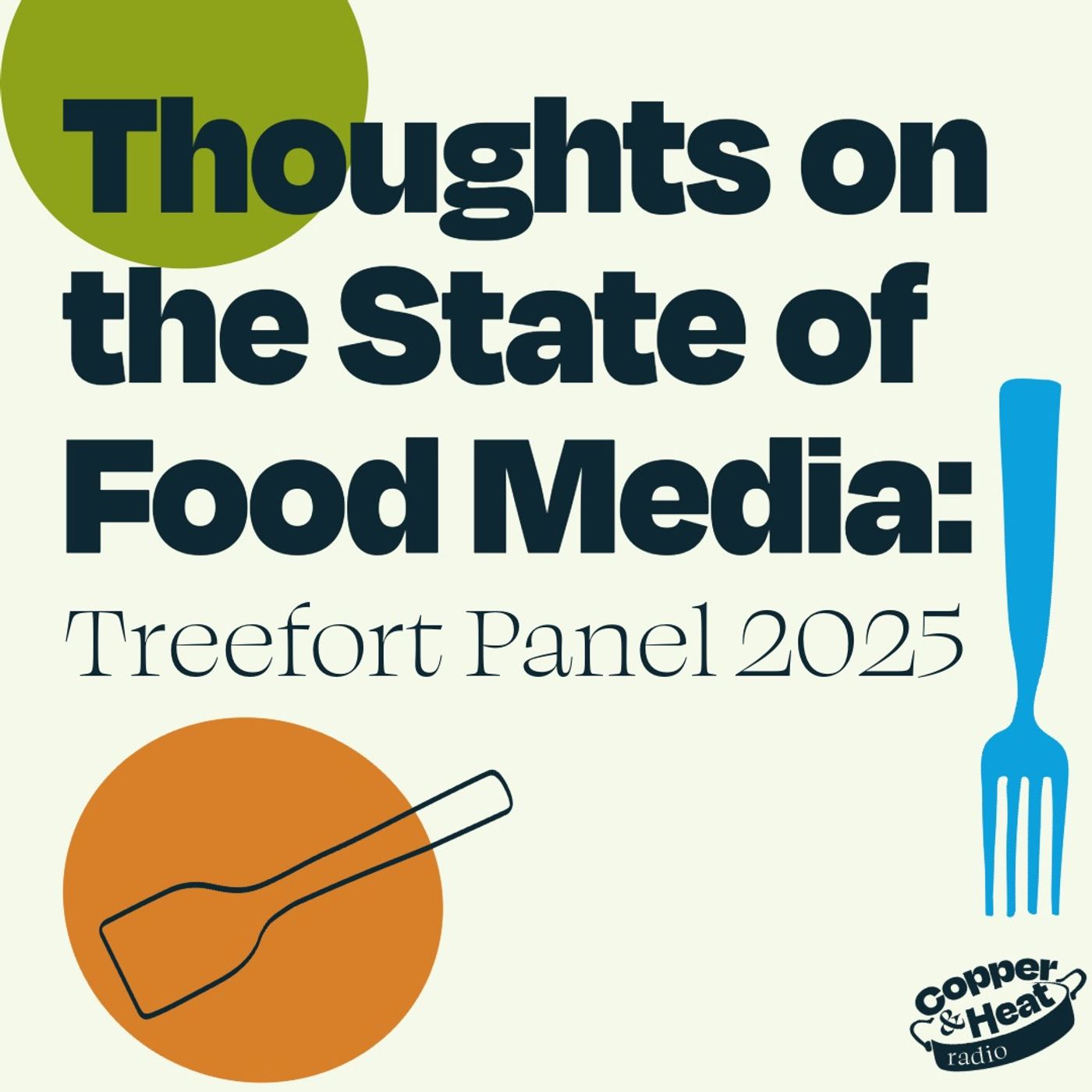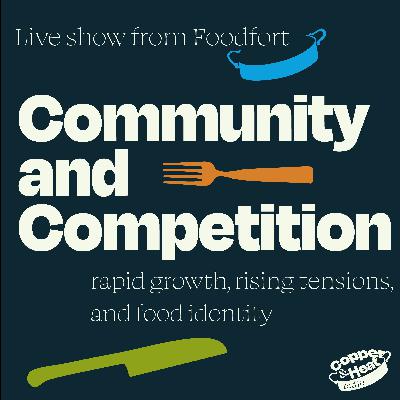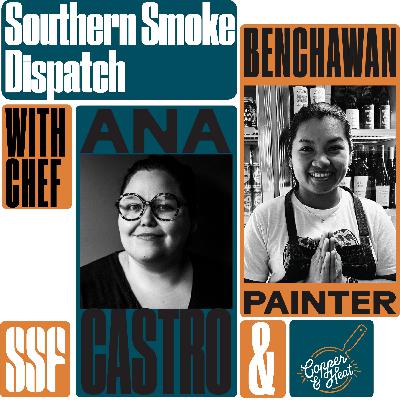Discover Copper & Heat Radio
Copper & Heat Radio

 Copper & Heat Radio
Copper & Heat Radio
Author: Copper & Heat
Subscribed: 124Played: 2,661Subscribe
Share
© Copyright 2019 - 2025 Copper & Heat LLC
Description
Copper & Heat Radio explores the forces that shape our meals through narrative, sound-rich podcasts. James Beard, Signal, and IACP Award winner. Part of Heritage Radio Network.
74 Episodes
Reverse
It is no secret that 2024 and 2025 have been tough years for food journalism in the United States, with a number layoffs happening across the industry. It’s against this national backdrop that at the end of March we hosted a panel discussion on the Podcast stage at Boise’s Treefort Music Fest.Our live podcast - also a part of Treefort’s Foodfort programming - brought together voices and perspectives from across Boise’s restaurant and food media landscape to tackle topics ranging from how the rise of new local media has affected the restaurants they cover, to the question of what makes someone an expert or authority on food? The conversation we had at Foodfort also touched on a lot of trends that are being experienced in cities all over the country. And so a few weeks after the panel, we also chatted with Dana Cowin, a former long-time editor of Food & Wine magazine, founder of Progressive Hedonist, and one of our colleagues at HRN, the Heritage Radio Network. Guests:Dana Cowin (Founder, Progressive Hedonist)Becca Alamilla (Co-owner, Amano)Kara Jackson (Managing Partner & Editor, BoiseDev Eats)Natalie Plummer (Creator, Hello Meridian and Podcast Host, The Boise Bubble)Scott Charles (Moderator, Boise Food Finds Facebook group)We are a part of HRN. Help us create a more sustainable world by shifting the way we think about food by supporting HRN's first ever two-week fundraising drive.
Exciting announcement: today Copper & Heat Radio is joining Heritage Radio Network, an independent, nonprofit podcast network with a mission to build a more sustainable world by shifting the way we think about food. To mark the occasion, we’re bringing our first episode ever back to the top of the feed. It’s called “Brigade”, and it’s the first episode in our James Beard Award-winning first season, Be A Girl, released in 2018. Why are restaurant kitchens organized the way they are? What is a kitchen brigade? What does a typical day of a cook look like? How does someone move up the ranks? And what do women do to work their way up the ranks in a kitchen? Some of the stats: Women make up a little over 50% of students graduating culinary schools Women make-up over 50% of total foodservice employees Somewhere between 30%-50% of back-of-house employees identify as women 27% of line cooks are ladies 19% of chefs are ladies 7% of head or executive chefs are ladies.
Join this second panel recorded live at the Roux event in Portland, Oregon in collaboration with Xcelerate. This episode delves into the journeys of four women entrepreneurs in the food industry as they navigate cultural influences, product development, and business growth. Moderated by Viridiana Ponce, the panel features discussions on the importance of community support, unconventional strategies, cultural authenticity, financial management, and the power of persistence. Listen in to learn how these women are making their mark and overcoming challenges in the CPG (Consumer Packaged Goods) world.Panelists include Holly Ong (Sibeiho), Sandra Arnerich (Renata), Kim Lehn (Sue Gee's), Christina Jessie (Market of Choice) and moderator, Viridiana Ponce. Learn more about Roux: https://www.rouxportland.com/aboutrouxLearn more about Xcelerate: https://www.xceleratewomen.org/
Join this panel (recorded live at Roux in Portland, Oregon) of industry-leading women entrepreneurs as they share candid and invaluable insights into navigating business growth through diverse investment strategies, including bootstrapping, venture capital, and angel investing. This deep-dive discussion covers essential aspects of targeting the right investors, maintaining profitability, and adapting to market changes. Learn about transitioning business models, the impact of iOS privacy updates on digital marketing, and the importance of multichannel marketing strategies. The conversation also highlights the power of organic marketing, building authentic brand communities, and the critical role of leadership in balancing innovation and brand consistency. Founders share their experiences on personal evolution, company culture, and leveraging leadership coaching to ensure sustainable growth. Whether you're an aspiring entrepreneur or a seasoned business owner, this episode offers a wealth of knowledge to help you secure capital, expand your business, and lead effectively.Panelists include powerhouses Jaclyn Johnson (Create & Cultivate + Cherub), Jing Gao (Fly by Jing), Maya French (Koia + HappyPop), Kat Craddock (Saveur). Moderated by Elizabeth Tilton (Oyster Sunday). Learn more about Roux: https://www.rouxportland.com/aboutroux
In this live podcast recorded at the Cookbook Fest in Napa, California, Copper & Heat Radio host Katy chats with Bricia Lopez and Brandon Skier. The two authors share their backgrounds, discuss their newly published cookbooks, and reflect on their personal journeys in the food industry. They delve into the nuances of restaurant versus home cooking, the significance of the chef title, and the challenges of translating professional culinary techniques for home cooks on paper. Guests:Bricia LopezInstagram | Website | Her books, Asada & Oaxaca Brandon SkierInstagram | TikTok | His book, Make It Fancy
In the last year, Boise was featured in two vastly different pieces of food news. First Chef Kris Komori of KIN brought home the first Boise James Beard Award. This same year, In N Out opened its first of four locations in the Boise area. In this episode, Katy discusses the rapidly changing restaurant industry in Boise, Idaho, recorded live at the Treefort Music Fest in March 2024. Katy and a panel of expert guests explore how the city's food identity has evolved with an influx of new residents and rising tensions over real estate and cultural shifts. The panel included local restaurateurs and industry advocates, who share their insights on the current state of Boise’s food scene, the workforce challenges, and the potential implications of Boise’s rapid growth. The episode also addresses the difficult questions raised by a local restaurateur about fostering true community and supporting independent restaurants amidst increasing competition from larger hospitality groups and real estate investors.Guests:Remi McManus from KIN RestaurantKatie Baker from FARE IdahoDr. Amanda Ashley from Boise State UniversityReno Rodriguez from the Hotel Renegade/Geronimo Hospitality GroupAudience question from Cal Elliot of Little Pearl and The Avery
In this guest episode from Loading Dock Talks with Chef Preeti Mistry, Preeti talks with Chefs Norma Listman and Saqib Keval, the duo behind Masala y Maíz and Marigold in Mexico City. The chefs share their unique culinary backgrounds and the melding of their heritages — Mexican, South Asian, and East African — into their cuisine. They discuss the process behind their lamb barbacoa recipe, a melding of Norma's Mexican family tradition with Saqib's South Asian flavors and spices. The discussion also explores the significance of maintaining cultural integrity while innovating with traditional recipes, avoiding the pitfalls of fusion for the sake of novelty. They also discuss the broader responsibilities of chefs in society, touching on labor rights in the restaurant industry, creating a supportive work culture, and the importance of political engagement through food. Listen to more Loading Dock Talks here or wherever you get your podcasts. More about the Copper & Heat Radio brand refresh: Many of you know us as Copper & Heat (the newly dubbed Copper & Heat Radio) which explores the forces that shape our meals through narrative, sound-rich podcasts.Copper & Heat Creative is an expansion of our award-winning storytelling. As a production studio, we focus on helping brands engage food-curious audiences with unique and thoughtful content. Over the past few years, we have done work we are really proud of with some amazing brands on projects ranging from podcast production to social media strategy and in-person event activation.At the heart of all of our work is our belief that food is a conversation. We tell stories that, like the best meals, challenge preconceived notions and delve into the forces that shape them.You can learn more about all of our work on our newly refreshed website: Copperandheat.com
Geraldine has started not one, but two international controversies with her blog "The Everywhereist." A three-time guest on Copper & Heat, we first chatted with her 5 years ago about imposter syndrome after winning a James Beard Award for her blog post about Mario Batali's cinnamon rolls, and then again 2 years ago after her blog post about her disastrous meal at Bros in Italy went viral. Geraldine's new book, "If You Can't Take the Heat: Tales of Food Feminism, and Fury" explores themes similar to those in her viral blog posts about the systemic challenges of being a woman working in food. In this interview, we talk about the challenges faced by women and non-binary individuals and the importance of speaking out against injustice. Geraldine shares her experiences with her viral blog post about Bros and the subsequent New York Times article, highlighting the biases and dismissive attitudes she encountered. The conversation delves into the pressure to perform a personal brand, as well as the experience of imposter syndrome. For more from Geraldine: Buy her new bookHer websiteHer Instagram | Threads
In this episode, Katy talks with chefs Reem Assil of Reem’s California in San Francisco, and Carlo LaMagna of Magna Kusina in Portland, OR, and Magna Kubo in Beaverton. Reem is a Palestinian-Syrian chef and activist who was a semifinalist for the James Beard Foundation Best Chef West award in 2018 and ‘19 and a finalist for the Outstanding Chef award in 2022. She won a 2023 IACP award for her cookbook, Arabiyya: Recipes from an Arab in Diaspora. Carlo’s restaurants highlight modern Filipino cuisine, and he was named one of Food & Wine’s Best New Chefs in 2021. He was nominated for a 2022 James Beard Foundation Award for Best Chef: Northwest & Pacific.In this episode, Katy, Reem & Carlo talk about redefining success and failure, cultural and family pressures when cooking their food, and how they take care of themselves.We recorded this episode in collaboration with the Southern Smoke Foundation and Visit Houston. Southern Smoke exists to take care of our own. As a nonprofit founded and powered by current and past F&B workers, they’ve felt the heat of the industry firsthand. Their efforts are dedicated to creating a meaningful safety net of support that doesn’t exist for most people in our world. To learn more about their emergency relief and mental health programs, visit their website. Reem AssilInstagram | Reem’s California | Her book, Arabiyya | Hospitality for HumanityCarlo LamagnaInstagram | Magna Kusina | Magna KuboSouthern SmokeInstagram | Get Help | DonateVisit HoustonInstagram | Website
In this episode, Katy talks with chefs Ana Castro of Lengua Madre in New Orleans, and “G” Benchawan Painter from Street to Kitchen and Th_Prsrv in Houston. Ana was one of the 2022 Food & Wine Best New Chefs and Lengua Madre was a Bon Appetit 50 Best New Restaurant. G won the 2023 James Beard Award for Best Chef: Texas.In this episode, Katy, Ana, and G talk about dealing with bad customers and reviews, discussing mental health with family, and the different ways they support their team.We recorded this episode in collaboration with the Southern Smoke Foundation and Visit Houston. Southern Smoke exists to take care of our own. As a nonprofit founded and powered by current and past F&B workers, they’ve felt the heat of the industry firsthand. Their efforts are dedicated to creating a meaningful safety net of support that doesn’t exist for most people in our world. To learn more about their emergency relief and mental health programs, visit their website. Ana CastroInstagram | Lengua Madre | About her new projectG Benchawan PainterInstagram | Street to Kitchen | Th_PrsrvSouthern SmokeInstagram | Get Help | DonateVisit HoustonInstagram | Website
In this first episode, Katy talks with chef and co-owner Emmanuel Chavez of Tatemó in Houston. Emmanuel was recognized as one of the 2023 Food & Wine Best New Chefs, and Tatemó was named a finalist for the 2023 James Beard Foundation Award for Best New Restaurant. In this episode, Katy and Emmanuel talk about his journey to quitting drinking, the responsibilities of leading and taking care of your team, and the ways he stays grounded as Tatemó gains more media attention. We recorded this episode in collaboration with the Southern Smoke Foundation and Visit Houston. Southern Smoke exists to take care of our own. As a nonprofit founded and powered by current and past F&B workers, they’ve felt the heat of the industry firsthand. Their efforts are dedicated to creating a meaningful safety net of support that doesn’t exist for most people in our world. To learn more about their emergency relief and mental health programs, visit their website. Emmanuel ChavezInstagram | Website Southern SmokeInstagram | Get Help | Donate Visit HoustonInstagram | Website
In this last episode of our 5 Year Reflection miniseries, we catch up with Kiah Fuller, co-owner of Far Out Catering in the Bay Area. Plus, we ask the question of all three of our interviewees: what's your biggest takeaway from the last 5 years?
In this episode, we catch up with Courtney Moisant, former pastry chef of Manresa Restaurant, pastry consultant, and founder of soon-to-open Gelato Coco. When Manresa Restaurant closed for good at the end of 2022, she decided to leave fine dining for good to start her own thing, a trend that Katy & Rachel explore more in the later part of this episode.
In this episode, we catch up with Edalyn Garcia. Of the 5 women we interviewed in Season 1, she is the only one still working full-time in restaurants and she's worked her way up to Executive Chef. Plus, Katy and Rachel get some updates on the stats of women working their way up the brigade in restaurants in the past 5 years. Last, we talk about why women chefs don't get as much media attention and funding when they are doing more innovative things to change the restaurant industry. The innovators that we mention in this episode: Telly Justice from HAGS in New YorkReem Assil of Reem's California in San FranciscoJenny Dorsey from Studio ATAO
Today's episode is from our friends over at The Sporkful. Zahra Tabatabai’s parents grew up in an Iran that would be unrecognizable today. “The pictures I see of my family in Iran in the sixties and seventies, they're in bikinis at the beach, drinking beer,” she says. Now, after the 1979 Islamic Revolution, women are legally required to wear hijabs and alcohol is banned. A few years ago, Zahra became interested in the long history of beer brewing in Iran — a tradition that included her own grandfather. She began brewing her own beer, experimenting with traditional Iranian ingredients like sumac, black lime, and barberries. Now she’s using her company, Back Home Beer, to change the narrative about Iranian people and culture. And one day, she hopes to bring her beer to Iran without fear. Nowruz Mobarak!The Sporkful production team includes Dan Pashman, Emma Morgenstern, Andres O'Hara, Nora Ritchie, Tracey Samuelson, and Jared O'Connell.
We have a guest episode this week from our friends at Opening Soon. In this season of Opening Soon, we’re undertaking a project we’ve been wanting to do for years. In The Build, we’re going to follow one chef’s journey to open a brand new restaurant as it’s happening. From the moment that they signed the lease until the doors are actually open, you’ll get to witness the emotional highs and the lows, how things go well, how things get delayed; all in real time. In this episode, we meet the subject of our series, hear a bit about their food journey so far, and get a sneak peek at what’s coming this season.
Less than $2. That’s how much the Santa Ana Unified school district can afford to spend on one student’s lunch each day. The $14 billion budget of the National School Lunch program stretches thin, and school nutrition workers are often the target of kids’ complaints. Reporter Jessica Terrell explores the cultural figure of “the lunch lady,” and how students and workers lose when bureaucrats focus on cost over care.This episode includes an annotated transcript with links to sources used in the reporting. This podcast was created by editors at The Counter and produced by LWC Studios. It is made possible by grants from the W.K. Kellogg Foundation and the Robert Wood Johnson Foundation.
When Katy was working in the Bay Area in her early 20s, she would have given the Michelin Guide 3 stars, because those were the restaurants she felt like she had to work to learn about the most innovative and interesting food. How has that changed?In this last episode of our fourth season, Katy and Rachel dig into the history, the data, and the money behind the Michelin Guide in the U.S. with help from Krishnendu Ray (professor at NYU) and Beth Forrest (professor at the CIA). By the end of the research, Katy and Rachel had very different ratings for the Guide than what their 24-year-old selves would have given it. What about you? Guests:Beth ForrestHer faculty bio and booksKrishnendu RayHis book | His faculty bio Articles mentioned and other resources:Florida’s Tourism Board Will Pay Michelin $150,000 to Rate the State’s RestaurantsWhy California Paid Michelin Guide $600,000 to Cover Los Angeles AgainThe Inspection ProcessMichelin Scatters Stars on New York (2005)The Fed-Up ChefThe Untold Truth Of The Michelin GuideThe High Price of a Michelin Guide: South Korea, Singapore, and Thailand have spent millions to get their own Red guidesThe History of the Michelin GuideHow Restaurants Get MIchelin Stars: A Brief History of the Michelin GuideThe Secret Life of an Anonymous Michelin Restaurant InspectorConfessions of a Michelin Inspector
Telly Justice and Mike Sheats worked together at Five & Ten in Athens Ga., where Justice worked her way up to chef de cuisine and Sheats was an AM chef. Once they started their own projects, the chefs knew that the strict brigade system, codified by Georges-Auguste Escoffier more than a hundred years ago, wouldn’t be the right fit for their businesses. “In the kitchens that Mike and I came up in, there was not much room for challenging anything,” said Justice. For both Justice and Sheats, the rigidity of the structure left no room for mistakes and little room for being themselves. Telly is now chef/co-owner of HAGS, a small tasting menu restaurant in New York City “by Queer people for all people,” and Mike, with his wife Shyretha, runs The Plate Sale, a pop-up inspired by community events like plate sales, barbecues, and fish fries in his hometown of Athens. This conversation was recorded as a chef-to-chef conversation for the Plate Magazine print edition. You can read an edited version of this conversation (and see some awesome pictures!) in their magazine here. But a less edited version of the conversation is here for your listening pleasure. Guests: Telly JusticeHAGS | HAGS InstagramPress: When ‘Sir’ and ‘Ma’am’ Miss the Mark: Restaurants Rethink Gender’s Role in ServiceHAGS Will Be Queer First, and a Restaurant SecondA First Look at HAGS, New York’s Revolutionary New Queer Fine DiningMike SheatsThe Plate Sale | The Crowdfunding Campaign | Instagram | Email Press: Honoring the History of the Plate SaleAn inside look at The Plate SaleMeet Shyretha and Michael Sheats: Founders of The Plate SaleResources:Understanding Anti-Intellectualism in the U.S. by Studio ATAOAnti-Intellectualism int he Restaurant Industry: Why an equitable future requires overhauling the brigade systemAn Investigation in Culinary Life and Professional Identity in Practice during Internship Escoffier Kitchen Brigade System Then and Now“OUI, CHEF!” A Sociohistorical Analysis of Organizational Culture in the American Fine Dining Kitchen Brigade and its Effects on Health from 1903 to 2019Why is anti-intellectualism so popular in kitchens?
The United States is the top producer of corn in the world, yet only 40% of that corn is destined for someone’s plate. The industrialization of corn in the Americas is a story of colonization, appropriation, and capitalism. But there are also stories of people finding ways to celebrate biodiversity, culture, and history through great corn products. In this episode, we talk with Pedro Ferbel-Azcarate and Wendy Downing, 2 of 3 co-owners of Three Sisters Nixtamal, an organic and traditional masa maker. We also talk with Angel Medina, co-owner of Repùblica and Co, a Mexican-forward restaurant group. Guests: Pedro Ferbel-Azcarate & Wendy DowningThree Sisters | InstagramAngel MedinaRepùblica & Co | Instagram Resources: To read more about what we talked about in this episode: Keepers of the Corn: Despite economic pressures, Oaxaca remains a stronghold of Mexico’s wondrous criollo, or native, corn varietiesHow Mexico’s iconic flatbread went industrial and lost its flavorThe Tortilla CartelUnited in Tradition as Peoples of the CornThe history of the world according to corn - TEDTalk by Chris A. KnieslyCorn: Origin, History, Technology, and ProductionHow Indigenous Seed Savers Safeguard Agricultural and Spiritual Tradition






















